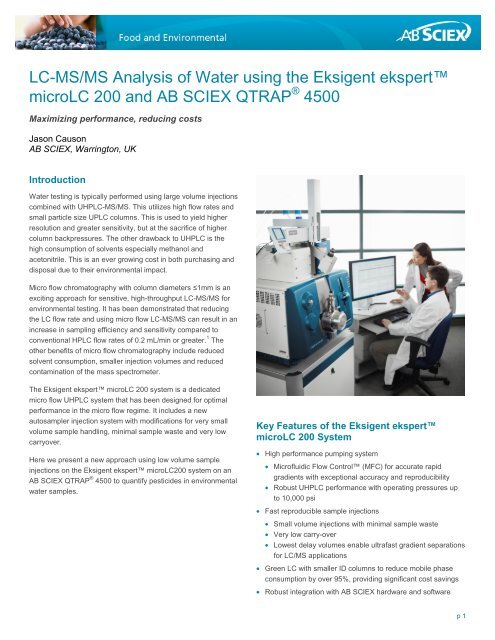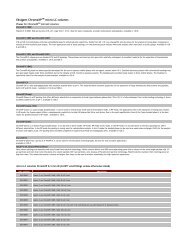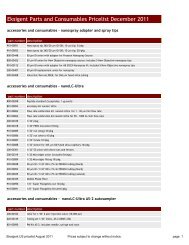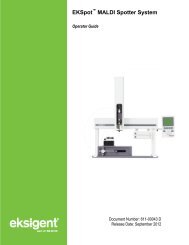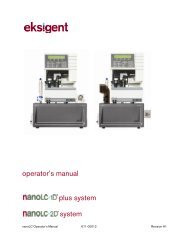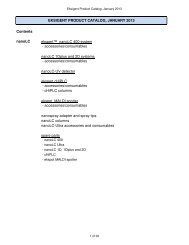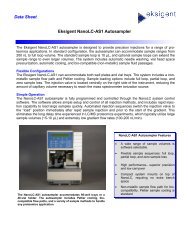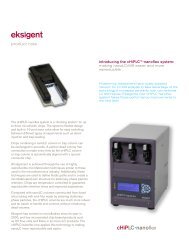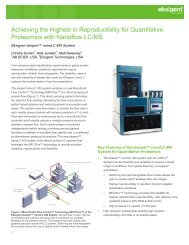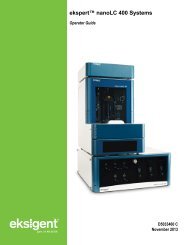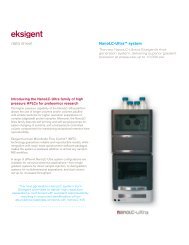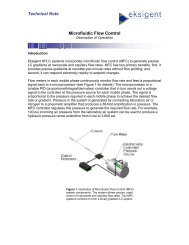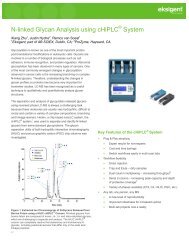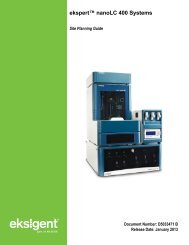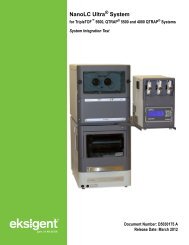AB SCIEX LC-MS/MS Analysis of Water using the Eksigent ekspert ...
AB SCIEX LC-MS/MS Analysis of Water using the Eksigent ekspert ...
AB SCIEX LC-MS/MS Analysis of Water using the Eksigent ekspert ...
- No tags were found...
You also want an ePaper? Increase the reach of your titles
YUMPU automatically turns print PDFs into web optimized ePapers that Google loves.
<strong>LC</strong>-<strong>MS</strong>/<strong>MS</strong> <strong>Analysis</strong> <strong>of</strong> <strong>Water</strong> <strong>using</strong> <strong>the</strong> <strong>Eksigent</strong> <strong>ekspert</strong>micro<strong>LC</strong> 200 and <strong>AB</strong> <strong>SCIEX</strong> QTRAP ® 4500Maximizing performance, reducing costsJason Causon<strong>AB</strong> <strong>SCIEX</strong>, Warrington, UKIntroduction<strong>Water</strong> testing is typically performed <strong>using</strong> large volume injectionscombined with UHP<strong>LC</strong>-<strong>MS</strong>/<strong>MS</strong>. This utilizes high flow rates andsmall particle size UP<strong>LC</strong> columns. This is used to yield higherresolution and greater sensitivity, but at <strong>the</strong> sacrifice <strong>of</strong> highercolumn backpressures. The o<strong>the</strong>r drawback to UHP<strong>LC</strong> is <strong>the</strong>high consumption <strong>of</strong> solvents especially methanol andacetonitrile. This is an ever growing cost in both purchasing anddisposal due to <strong>the</strong>ir environmental impact.Micro flow chromatography with column diameters ≤1mm is anexciting approach for sensitive, high-throughput <strong>LC</strong>-<strong>MS</strong>/<strong>MS</strong> forenvironmental testing. It has been demonstrated that reducing<strong>the</strong> <strong>LC</strong> flow rate and <strong>using</strong> micro flow <strong>LC</strong>-<strong>MS</strong>/<strong>MS</strong> can result in anincrease in sampling efficiency and sensitivity compared toconventional HP<strong>LC</strong> flow rates <strong>of</strong> 0.2 mL/min or greater. 1 Theo<strong>the</strong>r benefits <strong>of</strong> micro flow chromatography include reducedsolvent consumption, smaller injection volumes and reducedcontamination <strong>of</strong> <strong>the</strong> mass spectrometer.The <strong>Eksigent</strong> <strong>ekspert</strong> micro<strong>LC</strong> 200 system is a dedicatedmicro flow UHP<strong>LC</strong> system that has been designed for optimalperformance in <strong>the</strong> micro flow regime. It includes a newautosampler injection system with modifications for very smallvolume sample handling, minimal sample waste and very lowcarryover.Here we present a new approach <strong>using</strong> low volume sampleinjections on <strong>the</strong> <strong>Eksigent</strong> <strong>ekspert</strong> micro<strong>LC</strong>200 system on an<strong>AB</strong> <strong>SCIEX</strong> QTRAP ® 4500 to quantify pesticides in environmentalwater samples.Key Features <strong>of</strong> <strong>the</strong> <strong>Eksigent</strong> <strong>ekspert</strong>micro<strong>LC</strong> 200 System• High performance pumping system• Micr<strong>of</strong>luidic Flow Control (MFC) for accurate rapidgradients with exceptional accuracy and reproducibility• Robust UHP<strong>LC</strong> performance with operating pressures upto 10,000 psi• Fast reproducible sample injections• Small volume injections with minimal sample waste• Very low carry-over• Lowest delay volumes enable ultrafast gradient separationsfor <strong>LC</strong>/<strong>MS</strong> applications• Green <strong>LC</strong> with smaller ID columns to reduce mobile phaseconsumption by over 95%, providing significant cost savings• Robust integration with <strong>AB</strong> <strong>SCIEX</strong> hardware and s<strong>of</strong>twarep 1
ExperimentalLiquid Chromatography:All experimental data was acquired with <strong>the</strong> <strong>Eksigent</strong> <strong>ekspert</strong>micro<strong>LC</strong> 200 system equipped with a HTC-xt Dynamic Load andWash (DLW) autosampler. The <strong>ekspert</strong> micro<strong>LC</strong> 200 system’ssolvent delivery system is based on binary gradient pumps thatuse patented Micr<strong>of</strong>luidic Flow Control (MFC) pumptechnologyThe column used was an <strong>Eksigent</strong> ChromXP Halo Fused-Core2.7 µm, Phenyl Hexyl 0.5 x 150 mm. The column temperaturewas maintained at 30°C for all experiments. The mobile phaseswere ammonium formate in water and methanol. The flow ratewas set at 15 µL/min with a 4 µL injection volume.For <strong>the</strong> conventional HP<strong>LC</strong> experiments a Kinetex Fused-Corecolumn was used with a flow rate <strong>of</strong> 600 µL/min and a 4 µLinjection volume. The following gradient pr<strong>of</strong>ile was used for bothmicro flow and conventional flow (Table 1).Results and DiscussionThe aim <strong>of</strong> this work was to determine <strong>the</strong> quantitativeperformance <strong>using</strong> low volume injections with micro flow rates.To establish <strong>the</strong> performance a number <strong>of</strong> pesticides werespiked into water and serially diluted down to <strong>the</strong> limits <strong>of</strong>detection. The dilutions were analyzed at both flow rates;Figure 1 shows a comparison for Desphenyl-chloridazon at1ng/mL.Desphenyl-chloridazonMicro flow <strong>LC</strong>Desphenyl-chloridazonConventional flow <strong>LC</strong>Table 1. Analytical gradient pr<strong>of</strong>ile used at both flow ratesTime (min) A (%) B (%)Figure 1. Desphenyl-chloridazon analyzed <strong>using</strong> micro vs. conventionalflow <strong>LC</strong>-<strong>MS</strong>/<strong>MS</strong> (1 ng/mL)0.0 95 50.5 95 55.0 25 757.0 5 958.5 5 95At 1 ng/mL when comparing <strong>the</strong> peak areas at both flow rates<strong>the</strong> micro flow showed a 6.5 fold increase in peak area and a 10fold increase in signal to noise. The parent Chloridazon was alsoanalyzed and <strong>the</strong> comparison is shown in Figure 2.8.75 95 515.0 95 5Mass Spectrometry:The <strong>AB</strong> <strong>SCIEX</strong> QTRAP ® 4500 system was used for all dataacquisition. Analyses were performed <strong>using</strong> multiple reactionmonitoring (MRM) with simultaneous positive/negative switchingelectrospray ionization. The <strong>Eksigent</strong> hybrid 25 µm IDelectrospray electrode was used for all micro flow analyses. Thishybrid electrode is designed to minimize post column peakdispersion to maintain excellent peak shapes. 2 The sourcesettings were setup for micro flow rates with <strong>the</strong> curtain,nebulizer and heater gas set to 20 psi with a temperature <strong>of</strong>350°C. For <strong>the</strong> conventional flow rates <strong>the</strong> source conditionswere scaled to <strong>the</strong> appropriate values.ChloridazonMicro flow <strong>LC</strong>ChloridazonConventional flow <strong>LC</strong>Figure 2. Chloridazon analyzed <strong>using</strong> micro vs. conventional flow <strong>LC</strong>-<strong>MS</strong>/<strong>MS</strong> (1 ng/mL)p 2
At 1 ng/mL when comparing at both flow rates, micro flowshowed a 4 fold increase in both peak area and signal to noise.Both compounds showed when <strong>using</strong> <strong>the</strong> <strong>ekspert</strong> micro<strong>LC</strong> 200system significant sensitivity gains. Table 2 shows <strong>the</strong> lowerlimits <strong>of</strong> quantitation (LLOQ, where signal to noise is 10) for bothmicro and conventional flow.AtrazineAtrazine-desethylTable 2. Comparison <strong>of</strong> lower limits <strong>of</strong> quantitation (LLOQ)Compound NameLLOQ (ng/L)Micro Flow <strong>LC</strong>LLOQ (ng/L)Conventional Flow <strong>LC</strong>Chloridazon 50 500Desphenyl-chloridazon 50 500Figure 3. Calibration lines for Atrazine (top) and Atrazine-desethyl(bottom) with ‘r’ values <strong>of</strong> 0.999 or betterAtrazine 10 25Atrazine-desethyl 10 502,4-D 50 250Table 2 shows <strong>the</strong> <strong>ekspert</strong> micro <strong>LC</strong>200 system gave a 2.5 to10 fold lower limit <strong>of</strong> quantitation compared to conventional flowHP<strong>LC</strong>. The accuracy and precision <strong>of</strong> <strong>the</strong> micro flowmethodology was tested at and around <strong>the</strong> limits <strong>of</strong> quantitation.As shown in Table 3 all five pesticides gave very good precisionand accuracies <strong>of</strong> less than 10% and +/- 3% respectively.Table 3. Comparison <strong>of</strong> lower limits <strong>of</strong> quantitation (LLOQ)Compound Name CV (%) Accuracy (%)Chloridazon 6.6 102Desphenyl-chloridazon 4.2 101Atrazine 4.6 99Atrazine-desethyl 8.9 1032,4-D 3.9 103The linearity <strong>of</strong> response for atrazine and atrazine-desethyl wereanalyzed from <strong>the</strong> LLOQ to 1 μg/L. shown in Figure 3. Bothpesticides gave an ‘r’ value <strong>of</strong> 0.999 or better.ConclusionsWe have presented here a new approach for <strong>the</strong> analysis <strong>of</strong>pesticides in water. In order to use low volume injections, micr<strong>of</strong>low <strong>LC</strong> has been considered as a way to enhance performanceand maximize sensitivity. The use <strong>of</strong> reduced diameter columns<strong>using</strong> <strong>the</strong> HALO fused-core particle allowed for significantreduction in <strong>the</strong> flow rates, injection volumes and sampleconsumption. This combines to give sensitivity gains reducing<strong>the</strong> lower limits <strong>of</strong> quantitation by 2.5 to 10 fold.The o<strong>the</strong>r benefits <strong>of</strong> <strong>using</strong> micro flow technology is less massspectrometer down time and reduced cost <strong>of</strong> ownership. For atypical overnight batch <strong>the</strong> conventional flow rates would useover 0.5 L <strong>of</strong> solvent. Whereas <strong>the</strong> <strong>Eksigent</strong> <strong>ekspert</strong> micro<strong>LC</strong>200 system ran at 15 µL/minute used just under 13 mL <strong>of</strong>solvent. Therefore over <strong>the</strong> course <strong>of</strong> a year <strong>the</strong> micro flow <strong>LC</strong>would use approximately 1/40 <strong>of</strong> <strong>the</strong> solvent.References1 K. Mrizig et al.: ‘Enabling Fast Separations and SmallerSample Volumes in <strong>LC</strong>-<strong>MS</strong>/<strong>MS</strong> Using <strong>the</strong> <strong>ekspert</strong> micro<strong>LC</strong>200 System’ Technical Note <strong>Eksigent</strong> (2012) #6000112-012 K. Mrizig et al.: ‘Higher Sensitivity and Improved ResolutionMicr<strong>of</strong>low UHP<strong>LC</strong> with Small Diameter Turbo V Sourceelectrodes and Hardware for use with <strong>the</strong> expressHT-UltraSystem’ Technical Note <strong>Eksigent</strong> (2011) # 4590211-01For Research Use Only. Not for use in diagnostic procedures.© 2012 <strong>AB</strong> <strong>SCIEX</strong>. The trademarks mentioned herein are <strong>the</strong> property <strong>of</strong> <strong>AB</strong> Sciex Pte. Ltd. or <strong>the</strong>ir respective owners. <strong>AB</strong> <strong>SCIEX</strong> is being used under license.Publication number: 6440212-01HeadquartersInternational Sales353 Hatch Drive Foster City CA 500 Old Connecticut Path, Framingham, MA 01701 USA For our <strong>of</strong>fice locations please call <strong>the</strong> divisionPhone 508-383-7700headquarters or refer to our website atwww.absciex.comwww.absciex.com/<strong>of</strong>fices


